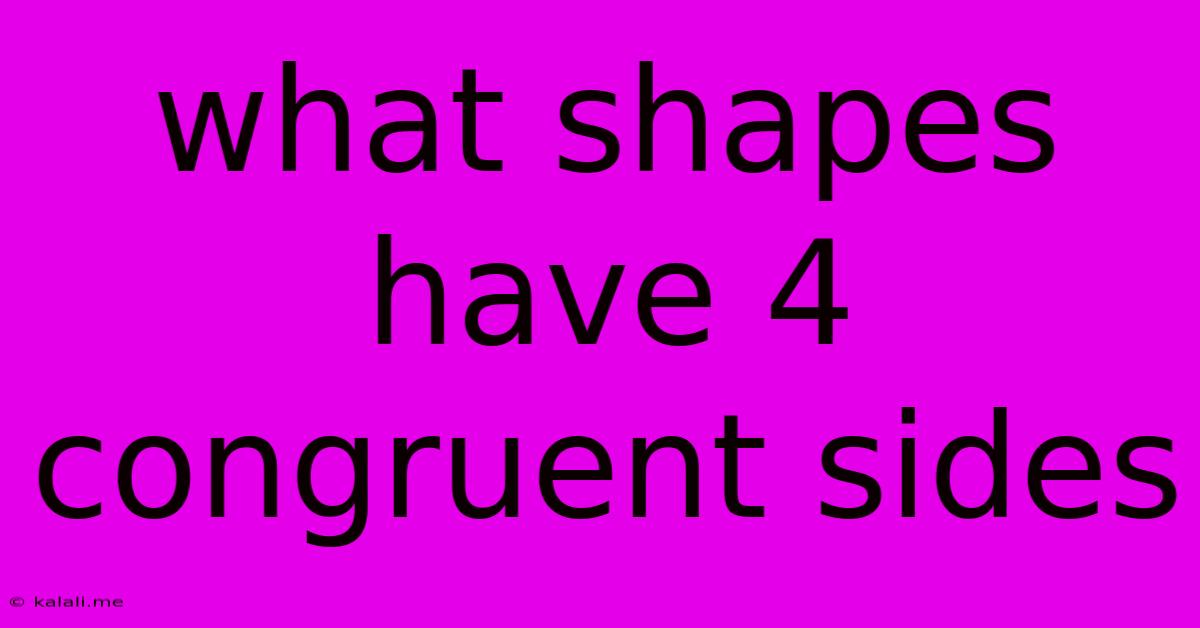What Shapes Have 4 Congruent Sides
Kalali
May 10, 2025 · 2 min read

Table of Contents
What Shapes Have 4 Congruent Sides? A Deep Dive into Quadrilaterals
What shapes have four congruent sides? This seemingly simple question opens the door to a fascinating exploration of geometry, specifically focusing on quadrilaterals. While the immediate answer might seem obvious, delving deeper reveals a nuanced understanding of geometric properties and the relationships between different shapes. This article will explore the various shapes with four congruent sides, highlighting their unique characteristics and differentiating factors.
The most common answer, and often the only one considered, is the square. A square, by definition, possesses four congruent sides and four congruent angles (all 90 degrees). However, there's another quadrilateral that also fits this description: the rhombus.
Understanding the Rhombus
A rhombus is a parallelogram with all four sides having equal length. Unlike a square, a rhombus's angles are not necessarily 90 degrees. This means a rhombus can be tilted, stretched, or compressed, maintaining its four congruent sides while altering its angles. Think of a square as a special case of a rhombus – a rhombus with right angles.
Here's a simple way to visualize the difference:
- Square: A perfectly symmetrical shape, with equal sides and right angles. Think of a tile on a floor.
- Rhombus: A parallelogram with equal sides, but angles that can vary from 0 to 180 degrees (excluding 0 and 180 themselves). Imagine a square that's been "pushed over" to one side.
Distinguishing Features: Key Differences between Squares and Rhombuses
To further clarify the distinction, let's highlight the key differentiating features:
| Feature | Square | Rhombus |
|---|---|---|
| Sides | 4 congruent sides | 4 congruent sides |
| Angles | 4 congruent angles (90°) | Opposite angles are congruent, but not necessarily 90° |
| Diagonals | Congruent and perpendicular | Not necessarily congruent, but always perpendicular |
| Symmetry | Rotational and reflectional | Reflectional symmetry only (across diagonals) |
Beyond Squares and Rhombuses: Considering other quadrilaterals
While squares and rhombuses are the most straightforward answers to the question, it's crucial to remember that the context of "congruent sides" can be interpreted differently depending on the specific geometric properties being considered. For instance, a quadrilateral with four congruent sides could be described as a special case of a parallelogram, but more accurately defined as either a square or a rhombus.
Conclusion: A deeper understanding of shapes
The seemingly simple question of what shapes have four congruent sides leads to a richer understanding of geometric properties and relationships between shapes. While a square is the immediately apparent answer, the rhombus represents a broader category of quadrilaterals sharing this characteristic. By understanding the nuances of squares and rhombuses, and their distinctive features, we develop a more comprehensive grasp of geometry. Remember, geometry isn't just about memorizing definitions; it's about understanding the connections between different shapes and their properties.
Latest Posts
Latest Posts
-
How Many Slices Of Turkey Is 3 Oz
Jul 06, 2025
-
Which Word Best Describes The Tone Of The Passage
Jul 06, 2025
-
How Long Does It Take To Count To One Billion
Jul 06, 2025
-
Why Did The Kangaroo See A Psychiatrist
Jul 06, 2025
-
How Long Would It Take To Walk To China
Jul 06, 2025
Related Post
Thank you for visiting our website which covers about What Shapes Have 4 Congruent Sides . We hope the information provided has been useful to you. Feel free to contact us if you have any questions or need further assistance. See you next time and don't miss to bookmark.